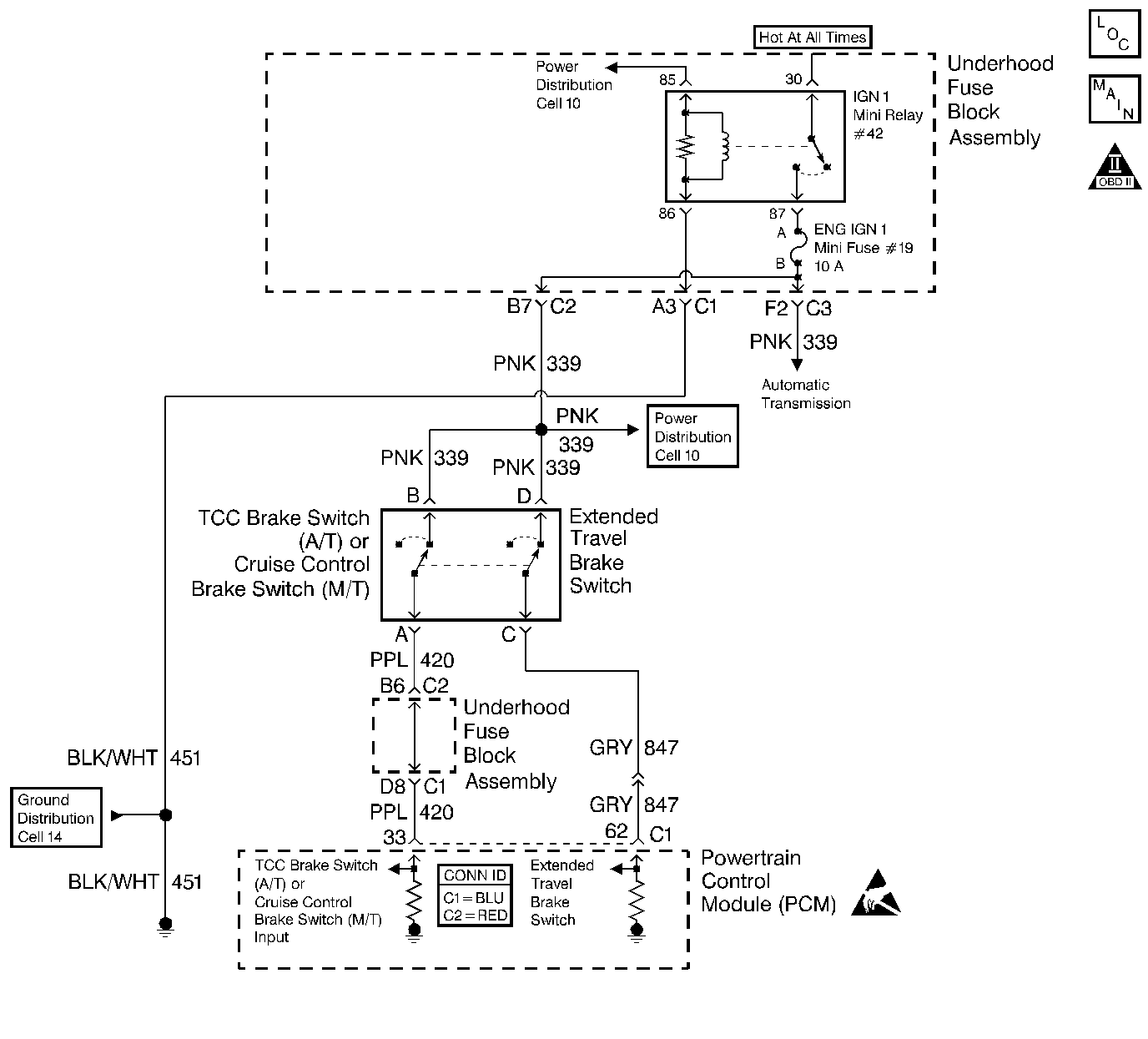
Circuit Description
This diagnostic test functions on the assumption that a brake application causes a sudden decrease in non-drive wheel speed.
The Extended Travel Brake Switch is a normally closed switch. When the Extended Travel Brake Switch is closed, the PCM senses ignition voltage on the Extended Travel Brake Switch signal circuit.
If the PCM senses a voltage on the Extended Travel Brake Switch signal circuit when the Extended Travel Brake Switch should be open, this DTC sets.
Conditions for Running the DTC
| • | The engine speed is greater than 700 RPM. |
| • | The engine has been operating longer than 2 seconds. |
| • | The wheel speed must be greater than 30 MPH in order to enable the diagnostic. The diagnostic will disable when the wheel speed is below 10 MPH. |
| • | The vehicle speed is decreasing at a rate greater than 10.4 MPH over a one second period. |
Conditions for Setting the DTC
| • | The PCM detects voltage on the Extended Travel Brake Switch circuit when the Extended Travel Brake Switch should be open. |
| • | The above conditions present for 1.5 seconds. |
Action Taken When the DTC Sets
| • | The powertrain control module (PCM) stores the DTC information into memory when the diagnostic runs and fails. |
| • | The malfunction indicator lamp (MIL) will not illuminate. |
| • | The PCM records the operating conditions at the time the diagnostic fails. The PCM stores this information in the Failure Records. |
Conditions for Clearing the MIL/DTC
| • | A last test failed, or the current DTC, clears when the diagnostic runs and does not fail. |
| • | A history DTC clears after 40 consecutive warm-up cycles, if failures are not reported by this or any other emission related diagnostic. |
| • | Use a scan tool in order to clear the MIL/DTC. |
Diagnostic Aids
Important:
• Remove any debris from the PCM\TAC module connector surfaces before
servicing the PCM\TAC module. Inspect the PCM\TAC module connector gaskets
when diagnosing/replacing the modules. Ensure that the gaskets are
installed correctly. The gaskets prevent contaminate intrusion into
the PCM\TAC modules. • For any test that requires probing the PCM or a component
harness connector, use the Connector Test Adapter Kit J 35616
. Using this kit prevents damage
to the harness/component terminals. Refer to
Using Connector Test Adapters
in Wiring Systems. • Test drive the vehicle if you cannot find a problem with the switch
or the circuit. An intermittent condition may be duplicated on a test drive.
| • | For Brake Lamp Switch adjustment, refer to Stop Lamp Switch Adjustment in Hydraulic Brakes. |
| • | This DTC does not set for an open circuit. If the PCM senses the Extended Travel Brake switch is Applied when the brake pedal is actually released a driveability concern may result. |
| • | For an intermittent condition, refer to Symptoms . |
Test Description
The numbers below refer to the step numbers on the diagnostic table.
-
An Extended Travel Brake switch signal that indicates Applied when the pedal is actually released may cause a driveability concern.
-
An Extended Travel Brake switch that is not properly adjusted may cause this DTC to set.
-
This step tests for an Extended Travel Brake Switch circuit for being shorted to B+.
Step | Action | Value(s) | Yes | No |
|---|---|---|---|---|
1 | Did you perform the Powertrain On-Board Diagnostic (OBD) System Check? | -- | ||
Does the display indicate Released? | -- | |||
3 |
Does the display indicate Applied? | -- | Go to Diagnostic Aids | |
Inspect the adjustment of the Extended Brake Travel switch. Refer to Diagnostic Aids. Was an adjustment necessary? | -- | |||
5 |
Does the display indicate Applied? | -- | ||
|
Important: Disconnecting the PCM may eliminate the short to voltage if the signal circuit is shorted to another PCM circuit.
Is the voltage greater than the specified value? | 0.5V | |||
7 |
Does the test lamp illuminate? | -- | ||
8 |
Does the scan tool indicate the Extended Travel Brake switch Released? | -- | ||
9 |
Does the DMM display continuity? | -- | ||
10 | Repair the short to voltage on the Extended Travel Brake switch signal circuit. Refer to Wiring Repairs in Wiring Systems. Is the action complete? | -- | -- | |
11 | Repair the open Extended Travel Brake switch ignition feed circuit. Refer to Wiring Repairs in Wiring Systems. Is the action complete? | -- | -- | |
12 | Repair the open Extended Travel Brake switch signal circuit. Refer to Wiring Repairs in Wiring Systems. Is the action complete? | -- | -- | |
13 |
Did you find and correct the condition? | -- | ||
14 | Replace the Extended Travel Brake switch. Refer to Stop Lamp Switch Replacement in Hydraulic Brakes. Is the action complete? | -- | -- | |
15 |
Did you find and correct the condition? | -- | ||
16 |
Important:: Program the replacement PCM. Refer to Powertrain Control Module/Throttle Actuator Control Module Replacement . Replace the PCM. Is the action complete? | -- | -- | |
17 |
Does the scan tool indicate that this test ran and passed? | -- | ||
18 | Select the Capture Info option and the Review Info option using the scan tool. Are any DTCs displayed that you have not diagnosed? | -- | Go to applicable DTC table | System OK |
